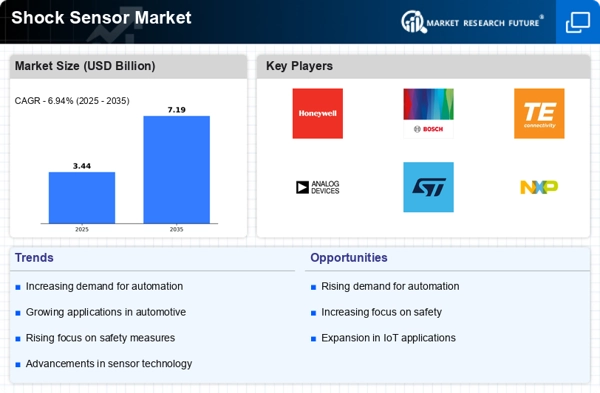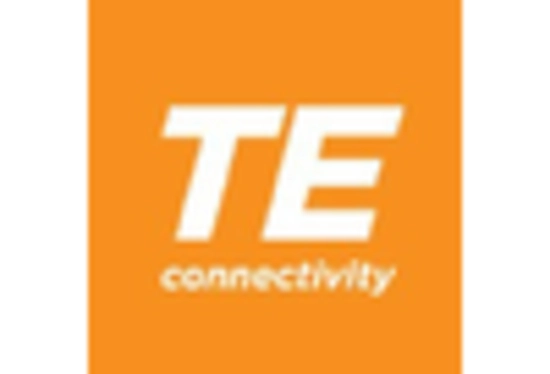Increased Demand for Safety Features
The growing emphasis on safety features across various sectors is significantly influencing the Shock Sensor Market. Industries such as automotive and aerospace are prioritizing the integration of advanced safety systems, which include shock sensors to detect impacts and prevent accidents. For instance, the automotive sector is increasingly adopting shock sensors in airbag deployment systems, enhancing passenger safety during collisions. According to recent data, the automotive segment alone accounts for approximately 40% of the total shock sensor market share. This heightened focus on safety is likely to propel the demand for shock sensors, as manufacturers strive to meet regulatory standards and consumer expectations. Consequently, the Shock Sensor Market is poised for growth, driven by the necessity for enhanced safety measures in various applications.
Rising Adoption in Consumer Electronics
The rising adoption of shock sensors in consumer electronics is significantly impacting the Shock Sensor Market. With the proliferation of smart devices, including smartphones, tablets, and wearables, manufacturers are increasingly incorporating shock sensors to enhance product durability and user experience. These sensors help protect sensitive components from damage due to accidental drops or impacts, thereby extending the lifespan of electronic devices. Recent market analysis suggests that the consumer electronics segment is expected to account for approximately 30% of the overall shock sensor market by 2026. This trend indicates a growing recognition of the importance of shock sensors in maintaining product integrity and consumer satisfaction. As a result, the Shock Sensor Market is likely to benefit from the increasing demand for robust and reliable consumer electronics.
Technological Advancements in Shock Sensors
The Shock Sensor Market is experiencing a notable transformation due to rapid technological advancements. Innovations in sensor technology, such as MEMS (Micro-Electro-Mechanical Systems), are enhancing the sensitivity and accuracy of shock sensors. These advancements enable the detection of even the slightest vibrations, which is crucial for applications in automotive, aerospace, and consumer electronics. The integration of IoT (Internet of Things) capabilities into shock sensors is also gaining traction, allowing for real-time monitoring and data analysis. This trend is expected to drive the market, as industries increasingly seek to leverage advanced technologies to improve safety and operational efficiency. As a result, the Shock Sensor Market is projected to witness substantial growth, with an estimated CAGR of around 8% over the next five years.
Expansion of Automotive and Aerospace Industries
The expansion of the automotive and aerospace industries is a key driver for the Shock Sensor Market. As these sectors continue to grow, the demand for advanced safety and monitoring systems is increasing. In the automotive industry, the integration of shock sensors in vehicles is becoming standard practice, particularly in advanced driver-assistance systems (ADAS) and collision avoidance technologies. Similarly, the aerospace sector is adopting shock sensors for structural health monitoring and impact detection in aircraft. Recent statistics indicate that the automotive sector is projected to grow at a CAGR of 5% over the next five years, further boosting the demand for shock sensors. This expansion is likely to create a favorable environment for the Shock Sensor Market, as manufacturers respond to the evolving needs of these dynamic sectors.
Focus on Sustainability and Eco-Friendly Solutions
The Shock Sensor Market is witnessing a shift towards sustainability, as manufacturers increasingly prioritize eco-friendly solutions. This trend is driven by growing environmental concerns and regulatory pressures to reduce carbon footprints. Companies are now exploring the use of sustainable materials in the production of shock sensors, which not only minimizes environmental impact but also appeals to environmentally conscious consumers. Furthermore, the development of energy-efficient shock sensors is gaining momentum, as these devices consume less power while maintaining high performance. This focus on sustainability is expected to create new opportunities within the Shock Sensor Market, as businesses seek to align their products with global sustainability goals. As a result, the market may experience a surge in demand for innovative, eco-friendly shock sensor solutions.
















Leave a Comment